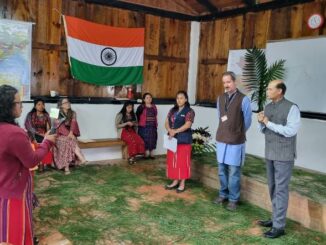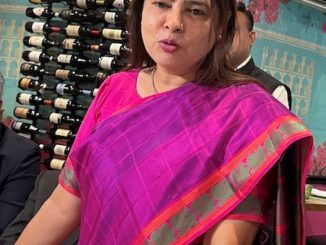
In the context of Azadi ka Amrit Mahotsav, celebrating India’s 75th year of Independence, it is an opportune moment to examine the achievements of the past, identify the remaining gaps, and aspirations for the Indian Centenary that will be celebrated in 2047. Once the largest economy of the world, India emerged from the colonial rule in 1947 as one of the poorest countries. Much has been achieved over the past 75 years in both economic and social terms. However, many challenges remain that need to be addressed over the next quarter century. In this essay, an overview of the key achievements and the gaps in India’s socioeconomic development is presented. It also offers a vision of India’s global leadership by 2047, not only in economic terms, but also in terms of prosperity that is more inclusive, more sustainable, and more resilient to enable her to celebrate the Centenary with a greater sense of national pride, achievement, and fulfilment, becoming a role model for the developing world.
one of the poorest countries. Much has been achieved over the past 75 years in both economic and social terms. However, many challenges remain that need to be addressed over the next quarter century. In this essay, an overview of the key achievements and the gaps in India’s socioeconomic development is presented. It also offers a vision of India’s global leadership by 2047, not only in economic terms, but also in terms of prosperity that is more inclusive, more sustainable, and more resilient to enable her to celebrate the Centenary with a greater sense of national pride, achievement, and fulfilment, becoming a role model for the developing world.
Key Achievements
India inherited a Shattered Economy at Independence. Economic historian Angus Maddison in his book The World Economy, a Millennial Perspective has documented that for much of the human history, India has been one of the largest and most prosperous economies of the world (Maddison, 2001). In the early eighteenth century when the British colonial powers entered and started colonising it, India was the largest economy of the world, accounting for as much as 27 percent of global GDP. India in that period was often described as the bird of gold (sone ki chiriya) and hence it attracted all the colonial powers and invaders in search of wealth. India was also described as the jewel in the British Crown.
The colonialisation proved to be a devastating experience for India, destroying its highly developed indigenous industries such as textiles, ship building, steel, among others. Some of these industries were highly sophisticated, as exemplified by superfine Dhaka Malmal or the Qutub Steel Pillar. These highly sophisticated indigenous industries were destroyed by the British in the period of the colonisation of the country to create markets for their own manufactured goods. India was pushed to become an exporter of raw materials to Britain and importer of everything manufactured, in a typical centre-periphery relationship as described by Latin American economist Raul Prebisch. By the time she gained independence, India had been reduced to be one of the poorest countries in the world with just over three percent of global GDP, compared to 27 percent of global GDP in 1700 AD.
Key Economic and Social Achievements
Sustained a rising trend of economic growth Perhaps one of the most important achievements has been the ability of sustaining a rising trend of economic growth over the past 75 years. Not only that growth has been there all along, but the trend rate is upward moving. The past few years have been challenging as the growth rates have been slowing down even before the onset of COVID pandemic. The pandemic has inflicted a rather heavy cost on the Indian economy, leading to a contraction by 7.4 percent in 2020–21, first time in four decades. However, in 2021–22, the Indian economy has been recovering very robustly and is likely to grow at about 8.5 to 9.5 percent, which will more than make up for the contraction of 2020–21. Hopefully, the Indian economy will again catch up with its rising growth trajectory in the next few years. The sustained and rising growth trend has helped India to constantly improve her rank in the global economy. India moved up to the fifth place from the ninth between 2010 and 2019, i.e. just in the space of ten years.
Contributor to poverty reduction in Asia
The other important achievement relates to poverty reduction. The head count rate of extreme poverty defined in terms of $1.9 a day has consistently declined over the years. In 1977, 63 percent of Indians were living in extreme poverty; this proportion declined to around 20 percent by 2011, the latest year for which the international numbers are available. Between 1990 and 2013 alone, 170 million people were lifted out of poverty. By now, India may have lifted over 500 million people out of poverty. However, in the past one and a half years, the pandemic has pushed millions of people who were on the edge of the poverty line into poverty due to widespread job losses. Hopefully, it is a temporary setback and as the pandemic related restrictions are lifted, these new poor would regain jobs and move above the poverty line.
Steady progress has also been made in terms of human development
India has also made sustained progress in terms of human development in terms of indicators of health and education. The adult literacy rate improved steadily to about 75 percent by 2011 from just 40 percent in 1981 when the last census was conducted. This is reflected in terms of enrolment ratios at primary, secondary, and tertiary levels of education. Similar improvement has been achieved in the life expectancy rate, an indicator of healthcare and nutrition. It has improved from 40 years to 70 years between 1960 and 2019. All different indicators of health of people including infant mortality/maternal mortality rates have also shown such similar improvements.
Improvements in access to infrastructure and financial inclusion
Similar improvements have been achieved in the access to infrastructure and financial inclusion. The access to electricity, for instance, has improved strongly in recent years. From only 50 percent of the population covered by access to electricity in 1995 and 76 percent in 2010, now 97 percent of people are covered. The coverage of sanitation has seen a huge jump under Swachh Bharat mission. Similarly, the coverage of financial inclusion has improved sharply under the Jan Dhan scheme under which 400 million accounts were opened, giving the poor easy access to modern financial services like banking. Almost all Indians are linked to world’s largest unique biometric identity called Adhaar. These are important achievements.
Emerging global leadership
India has attained global leadership in several areas. India’s global leadership in ICT software and business process outsourcing industry is very well recognised. India has consistently ranked number one in AT Kearney’s Global Services Location Index and has been maintaining leadership. It is also exemplified by the growing number of global tech giants, from Microsoft to Twitter, being headed by Indians. India is also known as the global pharmacy for its leadership in production of affordable generic pharmaceuticals. The COVID pandemic has helped to highlight India’s leadership in vaccine production, producing and supplying practically 50 percent of global vaccine requirements. India is also a world leader in production of compact cars and two wheelers. India is the largest milk producer in the world and the second largest producer of rice, wheat, sugarcane, groundnut, vegetables, fruit, and cotton. This is in sharp contrast to the times India has passed through in the early post- independence phase when she faced severe scarcity of food grains and had to sign an agreement with the United States under PL480 for food aid to feed the people.
Key Challenges
The achievements of India since independence in terms of socioeconomic development are truly substantial and impressive. However, there is no room for complacency, as much remains to be done to achieve the status of a developed country and for sustainable prosperity of all people in India. In what follows, we overview the remaining key challenges. Persisting poverty First of all, despite the fact that India has lifted 500 million people out of poverty over the past years, still over 20 percent of population lives in extreme poverty ($1.9 a day). If one
uses the $3.2 a day poverty threshold, which is the moderate poverty line, as many as 40 percent of Indians may be living in poverty. Unfortunately, updated international poverty numbers are not available as they come with a long lag. But clearly a very large proportion of India’s population is living in poverty and is deprived. The NITI Aayog (2021) has issued a multidimensional poverty index based on 12 indicators of health, education, and standard of living. The multidimensional poverty headcount rate in rural areas was nearly four times at 32.75 percent compared to 8.81 percent for urban areas. The rural areas that account for over two-thirds of India’s population, therefore, continue to face deprivations of basic amenities. This is also evident from an analysis of inequalities of opportunities, discussed later. There are also wide variations across states in terms of multidimensional poverty index with Bihar topping the list.
High incidence of hunger and malnutrition
Similarly, India continues to have high incidence of hunger and food insecurity even compared to other South Asian countries. India’s ranking in Global Hunger Index 2021 was 101, having slipped from the 2020 index of 94, out of 116 countries. The Hunger Index measures countries’ performance on four component indicators – undernourishment, child wasting, child stunting, and child mortality. The high incidence of hunger in India is enigmatic as there is enough food grain production and the granaries are full of food grains.
Source: ISID





Be the first to comment